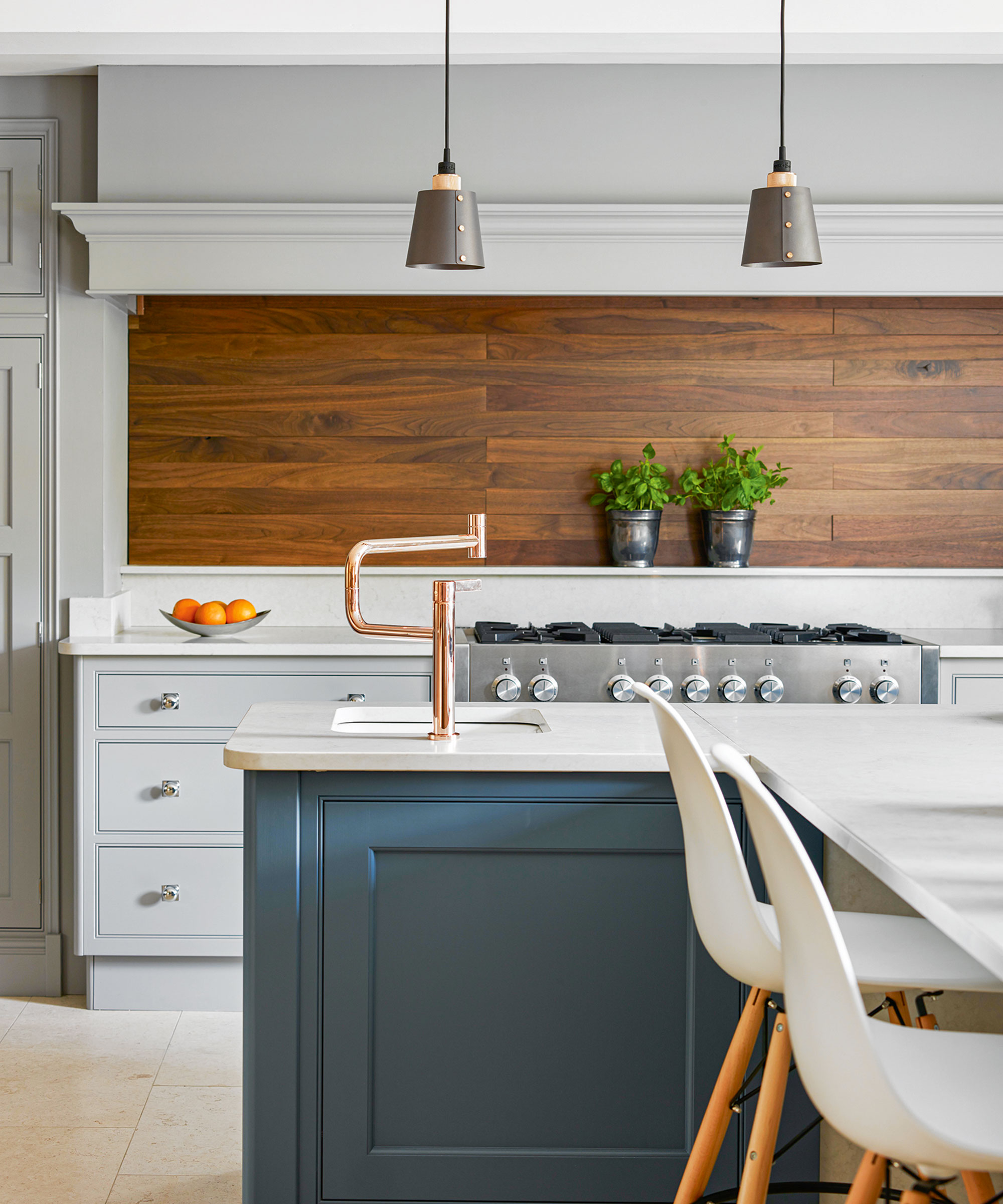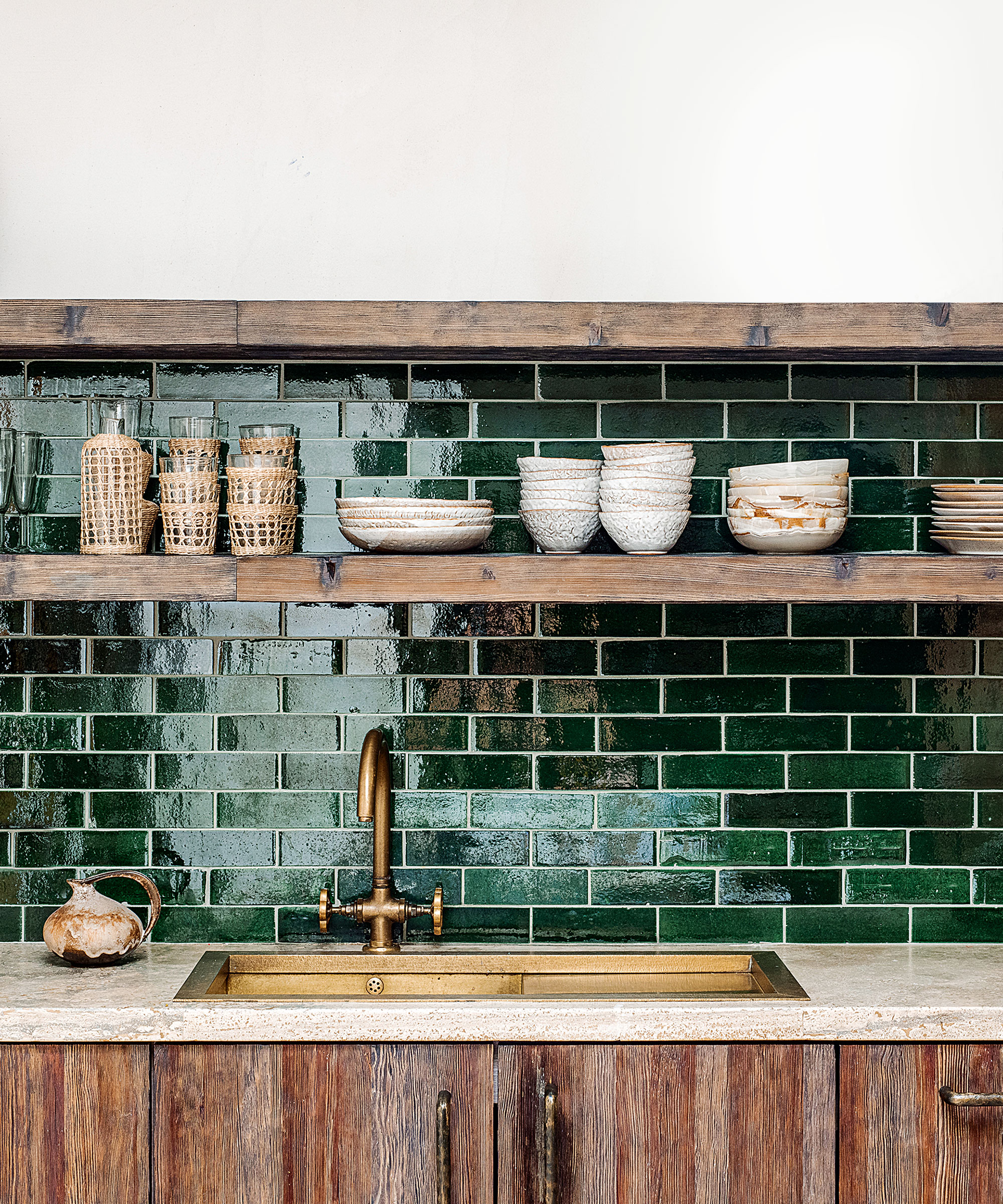The 'wallpaper' of the kitchen – why choosing the right kitchen backsplash can make or break a space
Make your kitchen's vertical surfaces shine with the best backsplash choice for your space

Linda Clayton

Choosing the right kitchen backsplash is one of the most important decisions you can make for your kitchen. While the point of a backsplash is to protect kitchen walls from spatter from the sink and hob, this wipe-clean surface has established a new design role, either as a subtle backdrop or a striking focal point.
These days, there is a wider choice of materials than ever. Along with the ubiquitous glass, tiles are enjoying a resurgence. Also available are specialist materials such as composite paneling, decorative choices including mirror and verre églomisé (gilded glass), and modern stalwarts such as stainless steel and grained timber veneers.
There are no hard and fast rules for choosing the right backsplash ideas for kitchens either – a modern finish can update a classic kitchen or a block of color can unify a large open space, echoing the color of accessories in a dining area. Anything goes if it’s up to the job.
'Your backsplash has to be able to perform on a practical level and not become a maintenance problem,' says Paul McDowell, MD Marketing for DuPont Surfaces. 'Look for materials that are strong, durable, non-porous, and easy to clean.'
How to choose the right kitchen backsplash?
No longer a matter of just finding a suitable material, the scale of the area that will be covered, the number of visible joins, and the cohesion between the countertop and walls will all impact the end result, so it is worth finding out more about the best kitchen backsplash materials available.
From a practical point of view, Mark Caulfield of Underwood Furniture, recommends one continuous smooth surface cladding the entire wall behind prepping and cooking areas. 'This will make it easy to wipe down and keep the area clean,' he explains. For a softer look, many backsplashes, particularly glass, steel, and composite materials, can be cut to form curves, arching higher over areas where they are needed most,' Caulfield adds.
Below, these kitchen backsplashes are a great example of how planning the practical elements of a space and the beauty of interior style have become intertwined when designing a kitchen, and will help you on your way to choosing the right kitchen backsplash for your home.
Design expertise in your inbox – from inspiring decorating ideas and beautiful celebrity homes to practical gardening advice and shopping round-ups.
1. Make a contemporary statement with a quartz backsplash

4011 Cloudburst Concrete quartz, Caesarstone
‘The material you choose for your kitchen surfaces is pivotal to the functionality of the space,’ says Mor Krisher, global head of design at Caesarstone. Tougher than most natural stones, man-made quartz comes in large slabs for virtually seamless installation. ‘Quartz is particularly great for backsplashes as it’s resistant to cracks, scratches, and, most importantly, staining,’ adds Mor.
Design-wise, recent improvements in quartz production techniques are introducing increasingly credible realism. The best designs eschew the uniformity of machine manufacture in favor of nature-inspired fluidity that brings surfaces to life.
2. Add textural interest and warmth with timber

Wood may seem an unusual choice for a backsplash but its natural depth will lend richness and warmth at eye level.
Here, Martin Moore used solid sculptured walnut with a special fire-rated lacquer finish to make it wipe clean and practical. ‘Wood is currently enjoying a bit of a revival, particularly walnut,’ says Richard Moore, design director at Martin Moore. ‘We love how it can be used to pick out warm tones in hand-painted cabinetry and rich metallic finishes like this rose copper tap.’
3. Modernize with marble

Often found gracing furniture, ceramics, glass, and lighting, the graceful linearity of fluted design is now weaving its magic into the modern kitchen.
In this project by Brian O’Tuama Architects, a fluted Calacatta marble backsplash was combined with natural wood cabinetry to provide a tactile treat hidden inside minimalist pocket doors.
‘We wanted the fluted marble to add visual interest and surface texture in contrast to the flat, contemporary exteriors,’ explains Brian O’Tuama. ‘The fluted surface creates areas of light and shadow, highlighting the character of the marble’s coloration and veining, and bringing that little bit extra to an already beautiful stone.’
4. Introduce stainless steel to a chef's kitchen

‘Stainless steel is durable, low-maintenance, and extremely hygienic, so it’s the ideal backsplash material for our present times, especially if you are an avid cook and wish to replicate a chef's kitchen,’ says Tom Edmonds, design director at Lewis Alderson.
‘It can be made into large complicated pieces with sinks and drainers welded in, virtually eliminating joints where bacteria and dirt could accumulate.’ While it is more often associated with contemporary kitchens, stainless steel can prove a surprisingly good fit amid traditional cabinetry.
‘In a classic kitchen, stainless steel lends a modern edge and, in time, will gain small swirl marks, which will settle into a lovely mellow patina that requires little fuss,’ adds Tom.
5. Set the trend with aged-copper

Aged-copper is incorporated in the Hampton Court kitchen, Naked Kitchens
Many of us may think metal backsplash ideas are only fitting for more industrial decor styles or ultra-modern kitchens, however, they can actually integrate into many different property types, from the classic to the contemporary.
Forget lackluster backsplashes – the space between the countertop and the wall cabinet is ripe for experimenting. Bespoke surfaces are the way forward, particularly those that feature natural pigmentations and imperfections for a truly individual look. This adventurous example is in hand-aged copper, which speeds up the oxidization process to bring forth beautiful verdigris.
6. Be bold and add color with brass

Brass and copper are relative newcomers to the backsplash arena, but these age-old materials are fast gaining fans. Brass specialist and maker James Petre, managing director of Quirky Interiors, believes the beauty of a warm metallic backsplash lies in bespoke customization. ‘Brass can be pre-aged to varying degrees, according to preference,’ he explains. ‘You do need to wipe up spills and should never scrub with abrasive cleaners, but with a little bit of Brasso and a dry cloth, a brass backsplash will just keep giving.’
7. Embrace the beauty of a tiled backsplash

A tile backsplash is nothing new, but there will be a shift away from matt finishes and towards gloss. A glazed tile is not just easy to clean – it will also reflect the light around the room, with effective results regardless of the color. Interior designer Natalia Miyar had these richly hued green tiles handmade in Florence.
‘Paired with the rustic wood and marble work surface, they create a really beautiful contrast with the earthy colors, as well as adding different layers of texture to the space,’ she explains. You don’t need to use a saturated shade to enjoy the full impact.
For a more muted look, choose glazed white tiles, which will certainly make the most of the natural light. Zelliges will also remain a popular choice. Handcrafted in Morocco, these distinctive glazed clay tiles, with their irregular surface and varying tones, bring texture and artisan character to a scheme.
8. Introduce vibrancy with wallpaper behind glass

Promoted from a purely practical role, the kitchen backsplash is fast becoming the ‘wallpaper’ of kitchens. Pitched close to eye level, they are also one of the first elements to be noticed when entering the room, so it’s worth making your choice of backsplash count.
If you’re looking for pattern, consider wallpaper. Tucked behind a protective screen of toughened glass, it’s a great low-maintenance way to enjoy botanical or floral prints, geometric repeats, or metallic foils. Compared to kitchen countertops, a backsplash is less in danger of major damage from spills and stains. That’s why you’ll often see beautiful marbles, which are really not tough enough for worksurface use, realized on a backsplash instead.
The best thing about a backsplash is that you don’t need a large area to make an impact. Just one square meter above a stove or sink is often all it takes, to put an otherwise unattainably expensive surface within reach.
What is the easiest backsplash to maintain?
If you are time-poor, finding a backsplash that is easy to maintain should be a priority.
Stainless steel is durable, relatively easy to maintain, and hygienic, which is why it is a popular option for a chef's kitchen. However, ceramic, glass, and porcelain options also fall into this category.
Take advice from your supplier with regard to cleaning. Marble and limestone can be pitted by acidic products, while stainless steel and glass require a non-abrasive cleaner to prevent scratching.

Jennifer is the Digital Editor at Homes & Gardens, bringing years of interiors experience across the US and UK. She has worked with leading publications, blending expertise in PR, marketing, social media, commercial strategy, and e-commerce. Jennifer has covered every corner of the home – curating projects from top interior designers, sourcing celebrity properties, reviewing appliances, and delivering timely news. Now, she channels her digital skills into shaping the world’s leading interiors website.